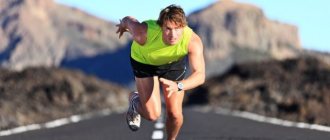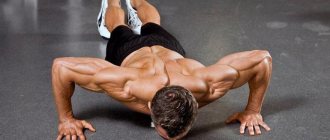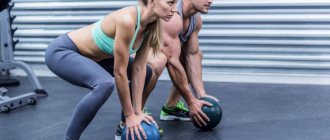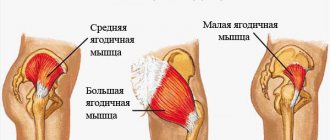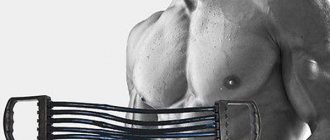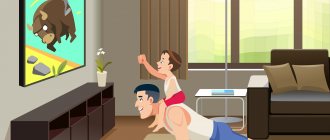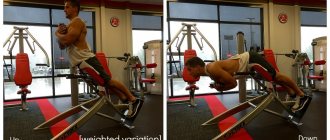What muscles are used on a bicycle?
Of course, you shouldn’t expect the same effect on growth from the muscular system as from training with dumbbells. “In order of decreasing load, the work is performed by the muscles of the front of the thigh, the muscles of the inner thigh, and the muscles of the lower leg,” lists Viktor Krutskikh, trainer of the Mytimefitness fitness club . - Again, in order of decreasing involvement, the gluteal muscles and the muscles of the back of the thigh are involved. The muscles of the back, abdomen and shoulder girdle work as stabilizers.”
We additionally load the legs
Advanced cycling enthusiasts are increasingly using toe clips (stirrup loops that secure the foot to the pedals) or contact pedals. In the second case, in addition to special pedals, you need special shoes (cycling shoes) with a spike that “snaps” into the pedal when landing. When stopping, the cycling shoes are unfastened by moving the foot to the side - easier than removing the foot from the toe clip. Fixing the foot on the pedal increases speed due to the additional inclusion of certain muscle groups in the work.
“On ordinary pedals, the so-called “treadmills,” the thigh and shin muscles work only when you push the pedal down,” explains Natalya Kozlovskaya, organizer of the VeloTolyatti Club cyclists club . — The pedal goes up due to the travel of the second pedal, which in the meantime you push down again. With clipless pedals and toe clips, you do a circular motion with your foot pushing down, then pulling up.” This more actively engages the back of the thigh and calf, and distributes the load on the legs more effectively.
Work for the core and arm muscles
The muscles of the core and upper extremities on a bicycle work primarily as stabilizers to maintain a certain body position and muscles. In this regard, with frequent long intense trips, problems with posture may arise.
“Being in a certain position for a long time, the stabilizer muscles shorten, that is, they become tight,” explains Viktor Krutskikh, “which often leads to pain in the elbow and shoulder joints, as well as in the back. To strengthen weakened muscles and relieve hypertonicity from shortened muscles, a combination of strength training and stretching will be an excellent addition to the bicycle.”
A post-bike workout plan might look like this:
- Immediately after riding, stretch for the pectoral and back muscles (trapezius, rhomboids, and levator scapulae), as well as the upper shoulder girdle. Various hangs on the horizontal bar, deflections, and moving your arms back are suitable.
- Then walk at an easy pace for 5-10 minutes to ensure the necessary rotation of the joints and return the body to its natural position.
- 2-3 times a week, perform resistance training for the shoulder girdle and back muscles and stretching for the entire body, including the back.
“You can add swimming,” says Natalya Kozlovskaya . “Remember, this only makes sense if you're riding regularly for long periods of time, not if you're riding once a week for an hour in the park.”
Bicycles can ruin your posture
If you don’t know what your seating position, handlebar and seat height should be, you can ruin your posture and even get injured. Due to incorrect positioning, there is a high probability of injury to the spine, shoulders and knees. Therefore, cycling is not just about getting on and going. There are many small nuances to consider.
While running, your back position will be more comfortable because it is physiological. When we walk or run, our body is in an upright position.
Photo: unsplash.com/@kbobike
Cycling and figure
With regular (3-4 times a week) cycling, the total energy consumption will increase. So you will burn fat mass and grow muscle mass, which will certainly make your figure more beautiful.
“During a long trip at a slow, even pace,” says Viktor Krutskikh, “ predominantly aerobic energy supply with the help of oxygen works. With such a load, the muscles will be toned, but the growth of muscle mass will be small, since the muscles work mainly for endurance. For short trips at a fast pace (or including such intervals), anaerobic energy supply will be activated. The muscles will receive energy without using oxygen. They will get tired faster, but grow and hypertrophy to a greater extent.”
How and why to do the bicycle exercise?
Olga Andrianova
World Class Triumph gym supervisor
When performing the exercise in movement, the rectus abdominis muscles are mainly used, as well as the calves and thighs. In addition, considerable stress falls on the lower back and lumbar region. Therefore, the exercise can be aimed at strengthening the back, improving posture, and also increasing endurance in the lower body. In addition to all of the above, the exercise also has a medical purpose. Doctors use it for the rehabilitation of knee and hip joints.
Technique:
- lie down on your back;
- Raise your straight legs so that they are perpendicular to the floor. From this position we begin to rotate our legs one by one;
- We perform the movement mainly with our calves, as if we were turning a pedal forward. We do not spread our legs to the sides.
Features of the technique:
the lower back, shoulders and shoulder blades are pressed to the floor, the movement is distributed evenly in the knee and hip joints; if the lower back is sensitive, we place the hands under the tailbone.
Photo: istockphoto.com
Why does cycling make your thigh muscles grow?
This question usually worries girls who are losing weight, who are afraid of getting even more voluminous legs in the riding breeches. In general, the growth of the muscles of the front surface of the thigh occurs due to the fact that, whatever one may say, they bear the main load.
“If you train hard and eat well, muscle growth is inevitable,” says Natalya Kozlovskaya. - But why avoid it? Muscular legs are strength, speed, beauty. Certainly better than skinny chicken feet. However, a bike ride in the park will not make your thigh muscles grow. The growth of muscle volume begins with intense training, when you ride 50-100 km 2-3 times a week.”
“In order to avoid excessive hypertrophy of the thigh muscles, it is necessary to work mainly at a slow, even pace,” adds Viktor Krutskikh, “avoiding the state of “acidification” - the so-called threshold of anaerobic metabolism.”
Thus, if you are afraid of muscle growth when cycling, ride at a moderate heart rate and for shorter distances - up to 30-40 km at a time. Fat burning will continue, but the muscles will not grow, they will only become denser and stronger.
Recommendations for the best exercises to strengthen muscles
From the endless variety of training methods, it is important to choose those that involve many muscles and develop important motor functions of the body. 9 tips from experienced cyclists:
- Gradually increase the intensity and duration of cycling loads. When choosing the pace of growth, focus on muscles that respond slowly to physical exercise. The increase should be 3−5% per day of the achieved result.
- During physical activity, the most vulnerable organ is the heart. Therefore, they focus on its capabilities first of all.
- Set the bike to a pace at which your heart rate increases to 11-12 beats per minute.
- When training, ensure a balanced diet and constant weight.
- Exercise on an exercise bike every day for 5-10 minutes at an average speed of 19-20 km.
- On a mountain bike, ride 10 km in 30 minutes, maintaining an average speed of 18-20 km.
- On a road bike, when riding on an asphalt road, move at a speed of 20-25 km.
- Strength, endurance, and pedaling speed are developed by squats and single-leg deadlifts.
- Stretching helps to relax and restore muscles after training.
For harmonious physical development, exercises are needed for all the muscles and joints of the body.
Cycling and the heart
Skating trains cardiorespiratory endurance and increases the ability of the heart muscle to tolerate stress. Typically, testing the heart under stress is carried out on a bicycle ergometer - a special exercise bike that sets the intensity.
“Any physical activity that is 60-80% of the maximum heart rate in the corridor has a beneficial effect on the functioning of the cardiovascular system,” explains Viktor Krutskikh. — A load close to the maximum heart rate leads to hypertrophy of the heart muscle. This can negatively affect the functioning of the cardiovascular system.” Thus, another argument is to ride at a moderate pace and without extreme loads.
“The only thing is that it is advisable to choose routes not along the sides of highways,” recalls Natalya Kozlovskaya. - There is not the same air that has a beneficial effect on the heart and lungs. But trips through forests, parks, meadows, where there are no cars, are priceless.”
Typical mistakes of beginner athletes
Bicycle is a simple exercise from a technical point of view, however, it also has its own little subtleties and secrets, by observing which you can get the maximum benefit from this exercise. Not all of them are obvious at first glance, so many beginners perform this exercise with technical errors. To fix this, you should seek help from a competent personal trainer. Or just read our article to the end, saving your time and money.
Below we will look at how NOT to perform the bicycle abdominal exercise:
- Perform the cycling exercise on a hard, stationary surface. If you do it on a soft surface, you will have less control over the movement and will spend energy on stabilizing the position of the body.
- Do not create an axial load on the cervical spine. When doing a bicycle, we simply place our palms on the back of our heads, but in no case do we press into it with all our strength. Yes, it may seem to you that this makes the exercise somewhat easier, but let’s not deceive ourselves. When training your abs, you should work your abs, not anything else.
- Maintain a uniform pace throughout the entire approach, the movement should be leisurely and smooth. If you do the exercise too quickly, you are unlikely to be able to fully concentrate on stretching and contracting your abdominal muscles.
- Observe the angles that are natural for your anatomy; there should be no discomfort. For example, if you feel an unpleasant stretching sensation in the sacrum area, it means you are raising your legs too much and you should reduce the range of motion.
- Don't chase the number of repetitions. This makes little sense, since in such exercises we first of all need a good muscle contraction due to an established neuromuscular connection. And the number of repetitions and approaches is a secondary matter. Another option is to try cycling for a while, for example, start with 30 seconds and gradually increase the load. So you will subconsciously give yourself a command that the “failure” of your abdominal muscles should occur precisely at the moment the time expires.
- Do not rush to use additional weights in this exercise. Even if you have been training for several years, and your abdominal muscles are strong and well developed, start doing the bicycle with the classic version - this way you will better understand the biomechanics of movement and learn how to correctly contract the abdominal muscles at different angles.
- Variety in the training process is the key to constant progress and athletic longevity. Don't be afraid to experiment and add something new to your training program. For example, the bicycle exercise can be performed either as part of a separate workout for the abs, at the end of a workout for the back or legs, or as part of a CrossFit complex.
Recipes for healthy eating
Cold Cucumber Shrimp Soup Recipe
- 1 g Protein
- 2.5 g Fat
- 2.1 g Carbohydrates
- 92 kcal
20-30 min.
- #dietary
- #breakfast
- #shrimps
- #seafood
- #low calorie
- #dinner
- #vegetables
- #cucumber
- #soup
- #puree soup
- #dinner
Other recipes
Useful exercises for cyclists
As a rule, special exercises are not required to prepare specifically for a cycling trip. Regular fitness training from autumn to spring, at home or in the gym, is enough.
“Any physical education will do,” says Viktor Krutskikh. - You can specifically strengthen the articular-ligamentous apparatus through static exercises - for example, a “chair”. But the main thing is to ride the bike, starting with short trips and eventually moving on to longer distances.”
Quite often, the passion for cycling outgrows the usual fitness limits and people begin to ride really a lot, increase their speed, and participate in bike rides or competitions.
“If your goal is to travel 200 km or 400 km (the so-called brevet), then you just need to start driving a lot and often,” explains Natalya Kozlovskaya. — A month of riding 10 km, but every day, will greatly increase endurance. What is more important here is the frequency of trips, their stability, and not training to failure once a week. Due to regularity, the body will get used to it, the muscles will get stronger, and a regimen of drinking and eating during the trip will be developed. During a long race, it’s important to drink on time to avoid leg cramps, and take carbohydrates on time to avoid loss of strength.”
If your goal is to ride for health and weight loss, then regularity is just as important. In this case, you should ride 3 to 6 times a week for 30-60 minutes, making sure that your heart rate does not exceed 70% of the maximum and having fun.
Inclusion in the training plan
The “bicycle” exercise can become an independent workout if you do it 10-15 times in 4-5 approaches per day. The main thing is to do it correctly, without trying to simplify the task. You can also include it in your training plan:
- as part of morning exercises;
- for warming up before strength training;
- as part of interval training;
- as a cool-down after a run or intense exercise at home.
Cycling is an exercise with which you can significantly correct your figure. It is useful for everyone who wants to have a strong and sculpted abs, slender legs and a healthy back. For people with imperfect posture, training will be a real boon.
The main thing is not to be lazy and not to give up. At first it will be difficult, since you will have to put in a lot of effort and experience pain in the muscles that are involved in the process of performing the exercise. But once you get used to it, it will be easy and comfortable to practice.
Exercise Bicycle: technique of execution.
Common mistakes when doing the exercise
Proper cycling is the key to a healthy body. If done correctly, a person will not be able to harm himself.
Beginners make mistakes that must be avoided so as not to cause harm to health.
The main ones:
- choosing a soft surface for performing the exercise - a sofa or bed puts additional stress on the lumbar region;
- making sudden movements, the speed of the lesson does not contribute to development - the useful properties of the bicycle are lost;
- holding your breath - blood pressure rises, heart function is disrupted;
- It is recommended to thoroughly and efficiently warm up before class - this will relieve sprains and prepare the joints for the load;
- it is necessary to rest between approaches - the body should rest well and prepare for the next approach;
- pain during exercise - move on to another exercise, consult a doctor;
- pulling your head up with your hands injures your neck.
Complicated version
How to do the “Bicycle” exercise correctly to achieve maximum results? You can complicate the technique by changing the angle of your hips relative to the floor. In other words, during movement, the legs should be as close to the surface as possible. At the same time, it is forbidden to touch the floor with them.
Otherwise, the complicated version is no different from the classic technique. The elbow also pulls toward the knee as the leg moves. Right elbow – left knee and vice versa.
This option is relevant only for those who are in excellent shape and regularly receive physical activity.
What else do you need to know
The “Bicycle” exercise for the abs, back, hips, and buttocks will be useful only if you do it regularly. Training from time to time will not help you get closer to your desired goal - figure correction.
The number of approaches is determined individually. For intermediate training, three approaches are shown. The optimal number of repetitions is 15. When performing the technique, you should pay attention to how you feel, do not chase immediate results and gradually increase the number.
Summarizing
The benefits of the “Bicycle” exercise are enormous, but it is not a panacea in the fight against excess weight. A mistake is made by those who expect to get rid of extra pounds through training alone.
With average exercise activity, a person gets rid of approximately 10 kcal per minute. Obviously, the training is aimed primarily at acquiring a beautiful relief, and then at burning calories.
When should you increase the number of sets and repetitions? This is done when a person feels that he does not have enough load. On average, three approaches are enough, with short pauses between them. The initial number of repetitions is from 8 to 10. Gradually this figure is increased to a maximum value of 20. You should not get ahead of yourself, this can lead to injury.
